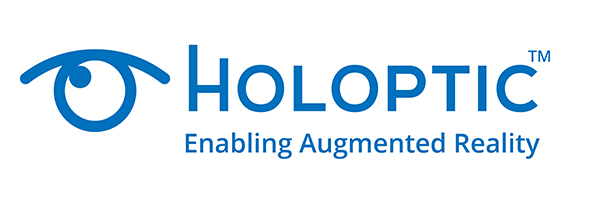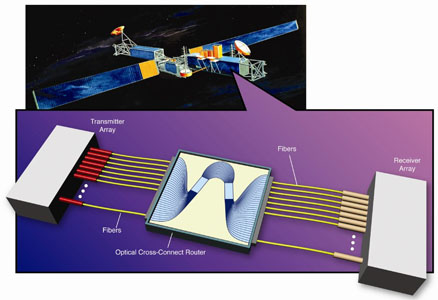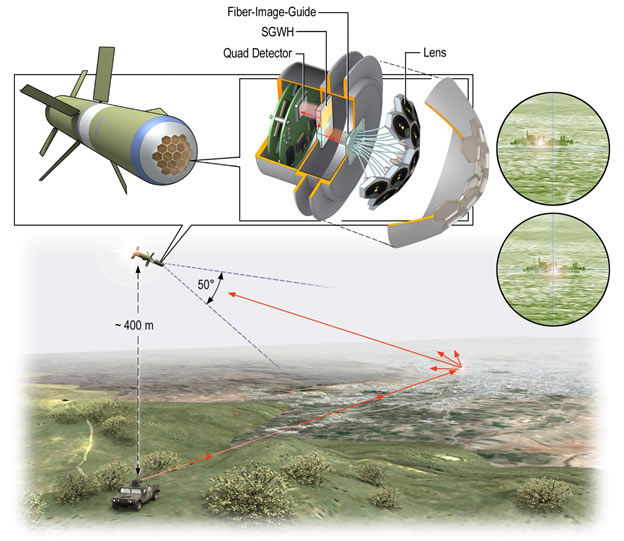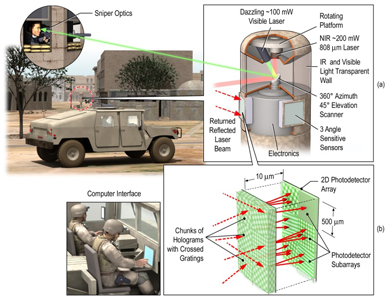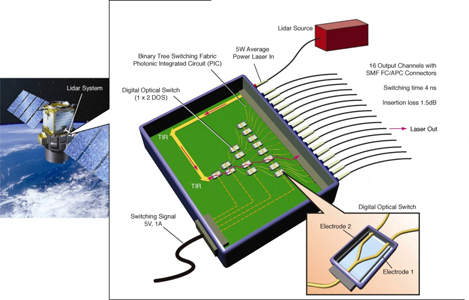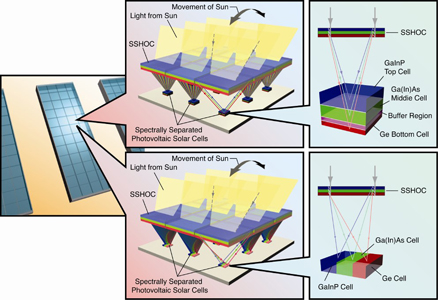Luminit GS is working with industries and governmental agencies to develop more than 20 cutting-edge technologies and is one of the nation’s leading electro-optics, fiber-optics and nano-photonics research group.
Integrated Cross-Connect Optical Switch
Luminit GS developed an innovative Integrated Cross-Connect Optical Switch (ICCOS) based on passive optical routing and active electronic switching. Data envelopes are sent via electrically controlled transmitters through an optical cross-connect router to burst-mode receivers. ICCOS can route the light to any output port through a non-blocking dense wavelength-division multiplexing cross-connect router.
Biomimetic Integrated Optical Sensor
For the Air Force, Luminit GS developed a new Biomimetic Integrated Optical Sensor (BIOS) system. The system is based on the unique integration of a wide field-of-view (FOV) miniature staring multi-aperture compound eye with a high-speed, low-cost, polarization and spectral selective liquid crystal (LC) filter array, a focal plane array (FPA), and a neural network processor. The BIOS system will use most if not all of the information in the light field, including spectral, temporal, polarization, and intensity for detailed object shape, for applications enabling autonomous behavior, including egomotion determination, to aid in navigation; as well as target detection, recognition, ranging, and tracking.
Ferroelectric Photogalvanic Generator
Luminit GS is developing anew Ferroelectric Photogalvanic Generator (FEPG), based on the Photogalvanic (giant photovoltaic) effect. FEPG consists of two blocks (removable for easy maintenance): 1. Pulsed light source, and 2. Ferroelectric cell. Power supplies may be diverse: an explosion-driven light source and battery-operated flash lamps could be used. If operated in deserts or in places with plenty of sunlight, concentrated sun radiation with a chopped window can be used as a power source. The major innovation in the FEPG is the use of a new physical principle of high-voltage generation, based on relatively new giant photovoltaic effect (GPE), or the photogalvanic effect.
Compound Eye Laser Missile Seeker
LGS is developing a compound eye laser missile seeker based on multi-aperture compound receiver optics (MACRO) and substrate-guided wave hologram (SGWH) filter. CELMS will consist of a MACRO, made of a lenslet array aligned with a flexible fiber-image-guide (FIG) array, an SGWH filter, a quad detector, and electronics and software.
Quantum Wave-converter
Luminit GS is developing a new high-efficiency, low-noise, and bidirectional plug-and-play fiber-coupled PPLN quantum wave-converter (Q-Waver) for quantum communications, based on Luminit’s patented substrate-guided wave hologram (SGWH) technology. The Q-Waver consists of a commercial PPLN waveguide chip, coupled with an innovative SGWH wavelength division multiplexer (WDM) at the input, and an innovative SGWH filter at the output.
Homogenized Hybrid Ultra Bright Backlight
Luminit GS developed an ultra-bright, ultra-thin, direct-view, Homogenized Hybrid Ultra-Bright Backlight based on mature Luminit diffuser technology and fully synchronized with AMLCD for low-cost, reliable electronics. The lighting on/off cycle is regulated by a smart synchronization scheme of line—imaging six lines by performing fast vertical frame integration so that a human eye sees a complete picture.
Holographic Preventive Advanced Counter-Sniper
For the Marines, Luminit GS developed a new Holographic Preventive Advanced Counter-Sniper device based on the latest advances in holography, laser-scanning techniques, and CMOS technology. This device uses the Bragg angle selectivity of shift and angle multiplexed thick transmission holograms, and the pattern imaged on a CMOS sensor when the holograms are illuminated with laser light to indicate the direction of a potential threat.
Fieldable Midwave Infrared Sum Frequency LADAR Sensor
LGS developed a novel fieldable midwave infrared sum frequency LADAR sensor for defense and homeland security. This LADAR sensor will detect midwave infrared light with a highly efficient silicon detector that exceeds the detection capability of current detectors by two orders of magnitude.
Holographic Interferometric Instrument for Threshold Stress Intensity
Luminit GS developed a new Holographic Interferometric Instrument for Threshold Stress Intensity based on a double-exposure holographic interferometric technique to study stress corrosion cracking, providing accurate and fast measuring of KIscc. It will capture relevant performance metrics so that it can be used to prepare a standard measurement procedure through a nationally recognized standards organization.
Fiber Image-Guide Airframe Roughness Profilometer
LGS developed a Fiber-Image-Guide Airframe Roughness Profilometer, based on a novel phase resolvable full-field optical coherence tomography (OCT) and a handheld Fiber-Image-Guide (FIG) probe, to examine aircraft and predict airframe crack nucleation prediction through surface roughness measurement.
Holographic Solar Concentrator Based on Substrate-guided Holograms
Luminit GS developed a new wideband holographic solar concentrator based on substrate-guided holograms and a flexible off-the-shelf thin-film photovoltaic cell positioned on the edge of the hologram. By using flexible highly efficient multiplexed substrate-guided holograms (SGH) recorded for the wide band of solar light and flexible thin-film PV cells that attach to the edge of the holograms, it efficiently covers the solar waveband and achieves up to a 300-fold solar energy conversion enhancement.
Fiber-Optic Phase Shifting Interferometer
For the Missile Defense Agency, Luminit GS developed a non-destructive interferometric technology for locating and characterizing surface and subsurface defects in aspheric silicon carbide (SiC) mirrors, which are critical to satellite and missile interceptor telescopes. This device, the Fiber Optic Phase Shifting Interferometer, has a modular design that enhances its use during mirror manufacture.
Performance Optimized Thermoelectric Generator
LGS developed a new innovative Performance Optimized Thermoelectric Generator system. This technology is based on an integrated system of highly efficient nanostructured flexible thermoelectric generators and thermal switches. POTEG will be lightweight and capable of supplying >300W of electricity to the power management system while removing heat from the insulation for at least 5 minutes and converting it to electricity.
High-Speed Fiber Optic Micro-multiplexer for Space and Airborne Lidar
Luminit GS developed a reliable, robust, high-speed Fiber Optic Micro-multiplexer, with a modular expandable binary tree switching architecture and photonic integrated micro-digital optical switches, that will provide space and airborne lidar imaging of Earth-Sun atmospheric parameters with a shaped field of view for an enhanced lidar return signal and image resolution.
Integrated Spatial Filter Array
Luminit GS developed a novel polarization preserving Integrated Spatial Filter Array based on photonically integrated waveguide technology consisting of polarization-preserving single-mode waveguide channels sandwiched between a pair of hexagonal microlens arrays. Each waveguide acts as a polarization-maintaining single-mode fiber.
Luminit Optical Tank-Level Sensing System
LGS developed a new non-contact Luminit Optical Tank-level Sensing system, based on the optical measurement of a small spotlight shone on the surface of the liquid. This approach incorporates commercial off-the-shelf components and Luminit cryogenic opto-mechanical design, which enables us to meet NASA requirements and offers the possibility of remote operation and compact size. This technology will replace multiple float switches and differential pressure measurements, which do not provide accurate liquid level measurements for low-density fluids such as, e.g., liquid hydrogen.
Flexible Spectrum Splitting Holographic Concentrators
Luminit GS developed a new thin, chromatic dispersion corrected, high efficiency, rugged, and low-cost flexible spectrum splitting holographic concentrator based on thin-film holographic optical elements. This holographic concentrator uniquely integrates four sets of thin-film holographic optical elements, individually compensated for dispersion, in order to concentrate light to the most appropriate layer of the PC cell.
Solar Photovoltaic Holographic Cogeneration System
Luminit GS developed a new Solar Photovoltaic Holographic Cogeneration system based on unique spectrum-splitting, sun-tracking Spectral and Angle Multiplexed Holographic Concentrator technology. Without any mechanical movement, the SPHOC tracks the sun and efficiently separates the visible portion of the sunlight for the standard PV cell from the thermal portion of the solar spectrum, which will be used to efficiently generate thermal or electric energy. SPHOC will continuously convert the focused sunlight in the visible and near-infrared(NIR) to cogenerate electric or thermal energy.
Holographic A-band Multi-channel Substrate Guided Wave-based System
Luminit Government Services developed a new imaging holographic A-band multi-channel substrate-guided spectrometer with high spectral resolution and high out-of-band rejection ratio. This technology applies two reflection substrate-guided wave-based holograms as dispersing elements laminated to a substrate. The solid integration of two high-resolution gratings enables high stability and image quality of the output spectrometer slit for entire resolved A-band spectrum.
Holographic Building Integrated Photovoltaics
LGS developed a new Holographic Building Integrated Photovoltaic material that uses highly efficient Luminit multiplexed holograms with expanded bandwidth and thin-film PV cells. This innovative technology will reduce the cost of photovoltaic system energy production. It will greatly improve the solar generating/concentrating systems resulting in increased solar energy yield. Specific commercial applications of HBIPV include space science and integrating in terrestrial buildings, or just as standalone energy systems.
Dual-Spectrometer Optical Coherence Tomography for Noninvasive Imaging of Intestinal Cancers
Luminit GS developed an innovative Dual-Spectrometer Optical Coherence Tomography endoscope that offers extremely fast, noninvasive tomographic imaging of the gastrointestinal tract. Based on an innovative dual-spectrometer design with self-elimination of autocorrelation interference, combined with Fourier domain OCT, DSOCT offers high-speed imaging with the highest sensitivity and resolution, much faster than endoscopy based on time-domain OCT.
Flexible Lightweight Radiation Protection Garment
Luminit GS developed a new Flexible Lightweight Radiation Protection Garment system based on our hybrid sol-gel technology for the protection of the warfighter, the physician, and the first-responder from radiation. This hybrid inorganic/organic polymer material system bridges the gap between inorganic and polymer for radiation protection in a coating with good mechanical and thermal stability, and high chemical resistance.
